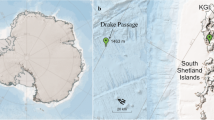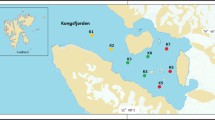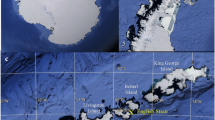Abstract
Increasing evidence of the fungal diversity in deep-sea sediments has come from amplification of environmental DNA with fungal specific or eukaryote primer sets. In order to assess the fungal diversity in deep-sea sediments of the Central Indian Basin (CIB) at ~5,000 m depth, we amplified sediment DNA with four different primer sets. These were fungal-specific primer pair ITS1F/ITS4 (internal transcribed spacers), universal 18S rDNA primers NS1/NS2, Euk18S-42F/Euk18S-1492R and Euk18S-555F/Euk18S-1269R. One environmental library was constructed with each of the primer pairs, and 48 clones were sequenced per library. These sequences resulted in 8 fungal Operational Taxonomic Units (OTUs) with ITS and 19 OTUs with 18S rDNA primer sets respectively by taking into account the 2% sequence divergence cut-off for species delineation. These OTUs belonged to 20 distinct fungal genera of the phyla Ascomycota and Basidiomycota. Seven sequences were found to be divergent by 79–97% from the known sequences of the existing database and may be novel. A majority of the sequences clustered with known sequences of the existing taxa. The phylogenetic affiliation of a few fungal sequences with known environmental sequences from marine and hypersaline habitat suggests their autochthonous nature or adaptation to marine habitat. The amplification of sequences belonging to Exobasidiomycetes and Cystobasidiomycetes from deep-sea is being reported for the first time in this study. Amplification of fungal sequences with eukaryotic as well as fungal specific primers indicates that among eukaryotes, fungi appear to be a dominant group in the sampling site of the CIB.




Similar content being viewed by others
References
Anderson IC, Campbell CD, Prosser JI (2003) Potential bias of fungal 18S rDNA and internal transcribed spacer polymerase chain reaction primers for estimating fungal biodiversity in soil. Environ Microbiol 5:36–47
Bass D, Howe A, Brown N, Barton H, Demidova M, Michelle H, Li L, Sander H, Watkinson SC, Willcock S, Richards TA (2007) Yeast forms dominate fungal diversity in the deep oceans. Proc R Soc B 274:3069–3077
Bauer R, Oberwinkler F (1991) The colacosomes: new structures at the host-parasite interface of a mycoparasitic basidiomycete. Bot Acta 104:53–57
Begerow D, Stoll M, Bauer RA (2006) Phylogenetic hypothesis of Ustilaginomycotina based on multiple gene analyses and morphological data. Mycologia 98:906–916
Borneman J, Hartin RJ (2000) PCR primers that amplify fungal rRNA genes from environmental samples. Appl Environ Microbiol 66:4356–4360
Cole JR, Chai B, Farris RJ, Wang Q, Kulam SA, McGarrell DM, Garrity GM, Tiedje JM (2004) The ribosomal database project (RDP-II): sequences and tools for high-throughput rRNA analysis. Nucleic Acids Res 33:D294–D296
Connell L, Barrett A, Templeton A, Staudigel H (2009) Fungal diversity associated with an active deep-sea volcano: Vailulu’u Seamount, Samoa. Geomicrobiol J 26:597–605
Damare S, Raghukumar C, Raghukumar S (2006) Fungi in deep-sea sediments of the Central Indian Basin. Deep-Sea Res PT-1 53:14–27
DeLong EF, Pace NR (2001) Environmental diversity of bacteria and archaea. Syst Biol 50:470–478
Edgcomb VP, Beaudoin D, Gast R, Biddle JF, Teske A (2011) Marine subsurface eukaryotes: the fungal majority. Environ Microbiol 13:172–183
Gao Z, Li B, Zheng C, Wang G (2008) Molecular Detection of Fungal Communities in the Hawaiian Marine Sponges Suberites zeteki and Mycale armata. Appl Environ Microbiol 74:6091–6101
Gao Z, Johnson ZI, Wang G (2010) Molecular characterization of the spatial diversity and novel lineages of mycoplankton in Hawaiian coastal waters. ISME J 4:111–120
Hongxiang X, Min W, Xiaogu W, Junyi Y, Chunsheng W (2008) Bacterial diversity in deep-sea sediment from north eastern Pacific Ocean. Acta Ecol Sinica 28:479–485
Jebaraj CS, Raghukumar C, Behnke A, Stoeck T (2010) Fungal diversity in oxygen-depleted regions of the Arabian Sea revealed by targeted environmental sequencing combined with cultivation. FEMS Microbiol Ecol 71:99–412
Kumar S, Nei M, Dudley J, Tamura K (2008) MEGA: a biologist-centric software for evolutionary analysis of DNA and protein sequences. Brief Bioinform 9:299–306
Kunčič MK, Kogej T, Drobne D, Gunde-Cimerman N (2010) Morphological response of the halophilic fungal genus Wallemia to high salinity. Appl Environ Microbiol 76:329–337
Lai X, Cao L, Tan H, Fang S, Huang Y, Zhou S (2007) Fungal communities from methane hydrate-bearing deep-sea marine sediments in South China Sea. ISME J 1:756–762
Li L, Kato C, Horikoshi K (1999) Bacterial diversity in deep-sea sediments from different depths. Biodivers Conserv 8:659–677
Liu WC, Li CQ, Zhu P, Yang JL, Cheng KD (2010) Phylogenetic diversity of culturable fungi associated with two marine sponges: Haliclona simulans and Gelliodes carnosa, collected from the Hainan Island coastal waters of the South China Sea. Fungal Divers 42:1–15
López-García P, Rodriguez-Valera F, Pedros-Alio C, Moreira D (2001) Unexpected diversity of small eukaryotes in deep-sea Antarctic plankton. Nature 409:603–607
López-García P, Philippe H, Gail F, Moreira D (2003) Autochthonous eukaryotic diversity in hydrothermal sediment and experimental microcolonizers at the mid-Atlantic Ridge. Proc Natl Acad Sci USA 2:697–702
López-García P, Vereshchaka A, Moreira D (2007) Eukaryotic diversity associated with carbonates and fluid-seawater interface in Lost City hydrothermal field. Environ Microbiol 9:546–554
Luna GM, Stumm K, Pusceddu A, Danovaro R (2009) Archaeal diversity in deep-sea sediments estimated by means of different terminal-restriction fragment length polymorphisms (T-RFLP) Protocols. Curr Microbiol 59:356–361
Nagano Y, Nagahama T, Hatada Y, Nunoura T, Takami H, Miyazaki J, Takai K, Horikoshi K (2010) Fungal diversity in deep-sea sediments-the presence of novel fungal groups. Fungal Ecol 3:316–325
Nath BN, Rao VP, Becker KP (1989) Geochemical evidence of terrigenous influence in deep-sea sediments up to 8°S in the Central Indian Basin. Marine Geol 87:301–313
O’Brien H, Parrent JL, Jackson JA, Moncalvo J, Vilgalys R (2005) Fungal community analysis by large-scale sequencing of environmental samples. Appl Environ Microbiol 71:5544–5550
Raghukumar C, Raghukumar S, Sheelu G, Gupta SM, Nath BN, Rao BR (2004) Buried in time: culturable fungi in a deep-sea sediment core from the Chagos Trench, Indian Ocean. Deep-Sea Res PT-1 51:1759–1768
Schloss PD, Westcott SL, Ryabin T, Hall JR, Hartmann M, Hollister EB, Lesniewski RA, Oakley BB, Parks DH, Robinson CJ, Sahl JW, Stres W, Thallinger GG, Horn DJV, Weber CF (2009) Introducing mothur: open source, platform-independent, community-supported software for describing and comparing microbial communities. Appl Environ Microbiol 75:7537–7541
Sharma R (2008) Project report: benthic environmental variability in the Central Indian Basin-III, Cruise #ABP26. National Institute of Oceanography, Goa, pp 1–170
Singh P, Raghukumar C, Verma P, Shouche Y (2010) Phylogenetic diversity of culturable fungi from the deep-sea sediments of the Central Indian Basin and their growth characteristics. Fungal Divers 40:89–102
Singh P, Raghukumar C, Verma P, Shouche Y (2011) Fungal community analysis in the deep-sea sediments of the Central Indian Basin by culture-independent approach. Microb Ecol 61:507–517
Snelgrove PVR, Blackburn TH, Hutchings P, Alongi D, Grassle JF, Hummel H, King G, Koike I, Lambshead PJD, Ramsing NB, Solis-Weiss V, Freckman DW (1997) The importance of marine sediment biodiversity in ecosystem processes. Ambio 26:578–582
Sogin M, Morrison HG, Huber JA, Welch DM, Huse SM, Neal PR, Arrieta JM, Herndl GJ (2006) Microbial diversity in the deep sea and underexplored “rare biosphere”. Proc Natl Acad Sci USA 103:12115–12120
Stackebrandt E, Liesack W, Goebel BM (1993) Bacterial diversity in a soil sample from a subtropical Australian environment as determined by 16S rDNA analysis. J FASEB 7:232–236
Stoeck T, Epstein S (2003) Novel eukaryotic lineages inferred from small-subunit rRNA analyses of oxygen depleted marine environments. Appl Environ Microbiol 69:2657–2663
Stoeck T, Taylor GT, Epstein SS (2003) Novel eukaryotes from the permanently anoxic Cariaco Basin (Caribbean Sea). Appl Environ Microbiol 69:5656–5663
Stoeck T, Hayward B, Taylor GT, Varela R, Epstein SS (2006) A multiple PCR-primer approach to access the microeukaryotic diversity in environmental samples. Protist 157:31–43
Takai K, Horikoshi K (1999) Genetic diversity of Archaea in deep-sea hydrothermal vent environments. Genetics 152:1285–1297
Takishita K, Miyake H, Kawato M, Maruyama T (2005) Genetic diversity of microbial eukaryotes in anoxic sediment around fumaroles on a submarine caldera floor based on the small-subunit rDNA phylogeny. Extremophiles 9:185–196
Takishita K, Tsuchiya M, Reimer JD, Maruyama T (2006) Molecular evidence demonstrating the basidiomycetous fungus Cryptococcus curvatus is the dominant microbial eukaryote in sediment at the Kuroshima Knoll methane seep. Extremophiles 10:165–169
Thompson JD, Higgins DG, Gibson TJ (1994) CLUSTAL W: improving the sensitivity of progressive multiple sequence alignment through sequence weighting, positions-specific gap penalties and weight matrix choice. Nucleic Acids Res 22:4673–4680
Urakawa H, Kita-Tsukamoto K, Ohwada K (1999) Microbial diversity in marine sediments from Sagami Bay and Tokyo Bay, Japan, as determined by 16S rRNA gene analysis. Microbiology 145:3305–3315
Whitman WB, Coleman DC, Wiebe WJ (1998) Prokaryotes: the unseen majority. Proc Acad Natl Sci USA 95:6578–6583
Acknowledgments
The first author is thankful to University Grants Commission for the award of Senior Research Fellowship and Dr. Rahul Sharma, NIO, Goa for the facilities extended during the research cruise. The crew members of the Russian research vessel Academic Borris Petrov are acknowledged for their support. The first two authors are grateful to the Director, NIO for the support extended. This is NIO’s contribution No. 5031.
Author information
Authors and Affiliations
Corresponding author
Rights and permissions
About this article
Cite this article
Singh, P., Raghukumar, C., Verma, P. et al. Assessment of fungal diversity in deep-sea sediments by multiple primer approach. World J Microbiol Biotechnol 28, 659–667 (2012). https://doi.org/10.1007/s11274-011-0859-3
Received:
Accepted:
Published:
Issue Date:
DOI: https://doi.org/10.1007/s11274-011-0859-3




